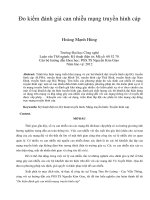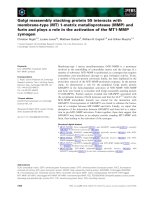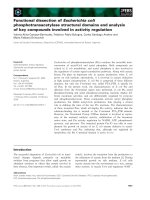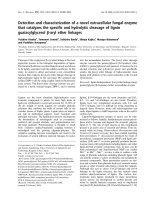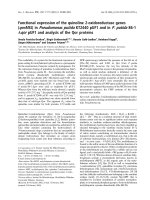Change detection and analysis of shoreline in the northeast of taiwan using remotely sensed data
Bạn đang xem bản rút gọn của tài liệu. Xem và tải ngay bản đầy đủ của tài liệu tại đây (2.55 MB, 51 trang )
THAI NGUYEN UNIVERSITY
UNIVERSITY OF AGRICULTURAL AND FORESTRY
NGUYEN VU TUAN ANH
CHANGE DETECTION AND ANALYSIS OF SHORELINE IN THE
NORTHEAST OF TAIWAN USING REMOTELY SENSED DATA
BACHELOR THESIS
Study Mode
: Full - Time
Major
: Environmental Science and Management
Faculty
: International Training and Development Center
Batch
: K44 – AEP
THAI NGUYEN - 2016
i
Thai Nguyen University of Agriculture and Forestry
Degree program
Bachelor of Environmental Science and Management
Full name
NGUYEN VU TUAN ANH
Student ID
DTN1253180060
Thesis title
Supervisor
Change detection and analysis of shoreline in the northeast of
Taiwan using remotely sensed data.
Assoc. Prof. Tang-Huang Lin and MSc. Nguyen Van Hieu
Abstract:
This study focuses on the use of remotely sensed data for monitoring coastline
changes from seven beaches located at the Yilan County in Taiwan during the 2000 to
2015 period. For the satellite image data processing, in this study we use the Modified
Normalized Difference Water Index (MNDWI) as it can efficiently suppress from the
water information the noise coming from built-up land, vegetation and soil. A GIS
(Geographic Information System) approach was used for the spatial analysis of
coastline change. It was observed that the coastline change in the Yilan County
underwent complicated changes during this 15 year period. In this period, the accretion
rate in Yilan coastal area was about 1.04 km and the erosion rate was about 0.34 km.
For the analysis of the changes of the coastlines, multi-temporal Landsat images have
been used. The zones of varying erosion and accretion have important implications for
coastal zone management in the Yilan County region.
Keywords
Yilan County, erosion, accretion, MNDWI, remote
sensing, geographic information system
Number of pages
Date of submission
i
ACKNOWLEDGEMENT
First and foremost, I wish to express my sincere thanks to the boards of Thai
Nguyen University of Agriculture and Forestry, Faculty of International Training and
Development Center; Advanced Education Program, for giving me this valuable and
unforgettable chance studying and working in Taiwan, and more important providing
me all necessary facilities, skills and knowledge to complete this bachelor thesis.
Furthermore, I want to deeply thanks to Assoc. Prof. Tang-Huang Lin (Head
of Environmental Remote Sensing Laboratory (ERSL), National Central University,
Taiwan) for given permission to accomplish my Bachelor thesis there, and also his
contact motivating supervision during my studies in the research group of ERSL, I
would like to thank to Ms. Nicole Wang, who provided me the materials for my
research.
This study was also supported and instructed by Professor Nguyen Van Hieu
(Head of Spatial Research Laboratory, Thai Nguyen University of Agriculture and
Forestry, Vietnam). In particular, I place on record my gratitude to him for the
multivariate analysis, and the knowledge of some significant change of sandy beaches
around the world. Without him, this work cannot be done.
Finally yet importantly, I take this opportunity to record my sense of gratitude
to my families and friends who encourage and backing me unceasingly.
Thank you very much!
Student signature
Nguyen Vu Tuan Anh
ii
TABLE OF CONTENTS
LIST OF FIGURES .......................................................................................................vi
LIST OF TABLES ..................................................................................................... viii
LIST OF ABBREVIATIONS .......................................................................................ix
PART I. INTRODUCTION ........................................................................................... 1
1.1. Research rationale ........................................................................................... 1
1.2. Research objectives......................................................................................... 3
1.3. The requirement. ............................................................................................. 3
1.4. Limitattions. .................................................................................................... 4
1.5. The significance . ............................................................................................ 4
PART II. LITERATURE REVIEW ............................................................................... 5
2.1. Theoretical basis ............................................................................................. 5
2.1.1. Shoreline erosion and accretion ................................................................... 5
2.1.2. Geographic information system (GIS)....................................................... 10
2.1.3. MNDWI method ........................................................................................ 11
2.2. Practical basis ............................................................................................... 13
PART III. METHODOLOGY ...................................................................................... 19
3.1. Material ......................................................................................................... 19
3.1.1. The objects ................................................................................................. 19
3.1.2. The scope. .................................................................................................. 19
3.2. Methods. ....................................................................................................... 19
3.2.1 Collecting and selecting data. ..................................................................... 19
3.2.2 Software. ..................................................................................................... 20
iii
3.2.3. Flowchart of methodology. ........................................................................ 20
3.3.. Image pre-processing. .................................................................................. 21
3.3.1 Radiometric correction. .............................................................................. 21
3.3.2 Geometric correction. ................................................................................. 22
3.4. Compute Modified Normalize Difference Water Index (MNDWI)............. 23
3.5. Overlay.......................................................................................................... 24
PART IV. RESULTS ................................................................................................... 25
4.1. Result of shoreline change detection map .................................................... 25
4.1.1. Radiometric correction .............................................................................. 25
4.1.2 Geometric correction .................................................................................. 27
4.1.3. Compute Modified Normalize Difference Water Index (MNDWI) .......... 28
4.1.4. Overlay ..................................................................................................... 30
4.2. Shoreline change mapping in research area ............................................ 31
PART V. DISCUSSION AND CONCLUSION .......................................................... 38
5.1. Discussion ..................................................................................................... 38
5.2. Conclusion .................................................................................................... 38
REFERENCES ............................................................................................................. 39
iv
LIST OF FIGURES
Figure 1.1. Different types of coasts in Taiwan ............................................................1
Figure 1.2. Map of study area .........................................................................................1
Figure 2.1. Typhoon routes and No. of occurrence (1897 - 1997) .................................8
Figure 2.2. Relative spectral response (RSR) profiles showing the spectral band
difference between Landsat-8 Operational Land Imager (OLI) (solid curve) and
Landsat-7 Enhanced Thematic Mapper Plus (ETM+) (short dot curve) ......................12
Figure 3.1. The flowchart of analysis procedure .........................................................20
Figure 3.2. Band 7,4,2 ..................................................................................................21
Figure 3.3. Band 3,2,1 .................................................................................................21
Figure 3.4. Band 4,3,2 ..................................................................................................21
Figure 4.1. Radiometric correction of Landsat 7 .........................................................25
Figure 4.1a. Original ....................................................................................................25
Figure 4.1b. Radiometric calibration ...........................................................................25
Figure 4.1c. Region of interest ....................................................................................25
Figure 4.1d. Dark object subtract ................................................................................25
Figure 4.2. Radiometric correction of Landsat 8 ..........................................................26
Figure 4.2a. Original ....................................................................................................26
Figure 4.2b. Radiometric calibration ...........................................................................26
Figure 4.2c. Region of interest .....................................................................................26
Figure 4.2d. Dark object subtract ................................................................................26
Figure 4.3. Landsat image 2000 ...................................................................................27
Figure 4.4. Landsat image 2015 ...................................................................................27
vi
Figure 4.5. The registration between Landsat image 2000 and 2015 ..........................28
Figure 4.6. MNDWI (Landsat 7) .................................................................................29
Figure 4.7. MNDWI (Landsat 8) ..................................................................................29
Figure 4.8. Overlay ......................................................................................................30
Figure 4.9. Shoreline change detection map in Yilan county, 2000 - 2015 .................31
Figure 4.10. Shoreline change detection map in Waiao beach and Wushi port, 2000 2015 ..............................................................................................................................33
Figure 4.11. Shoreline change detection map at the south of Toucheng Township, 2000
- 2015 ............................................................................................................................34
Figure 4.12. Shoreline change detection map at the coast of Zhuangwei Township,
2000 - 2015 ...................................................................................................................35
Figure 4.13. Shoreline change detection map at the coast of Wujie Township, 2000 2015 ..............................................................................................................................36
Figure 4.14. Shoreline change detection map at the north of Su'ao Township, 2000 2015 ..............................................................................................................................37
vii
LIST OF TABLES
Table 3.1. Satellite and sensor characteristics ...............................................................19
viii
LIST OF ABBREVIATIONS
CPAMI
Construction and Planning Agency under
the Ministry of the Interior
CSRSR
Center of Space and Remote Sensing
Research
DN
Digital Number
ETM+
Enhanced Thematic Mapper Plus
GCP
Ground Control Point
GIS
Geographic information system
GPS
Global Positioning System
MNDWI
Compute
Modified
Normalized
Difference Water Index
OLI
Operational Land Imager
RS
Remote sensing
RSR
Relative Spectral Response
SWIR
Short-wave infrared
ix
PART I. INTRODUCTION
1.1. Research rationale
The total length of Taiwan’s shoreline is approximately 1,100 kilometers
including sand, rock, cliff, gravel and reef coasts. Taiwan is frequently attacked by
typhoons, particularly serious in the Yilan County of northeastern Taiwan (Figure 1.1),
and shoreline erosion is a major concern to local residents. There always exists a panic
among residents whenever a typhoon strikes because typhoons inevitably cause a
threat to their safety and property. The Yilan County is an alluvial plain surrounded by
mountains on three sides, and its east coast borders the Pacific Ocean with a coast
length of about 103 km from north to south. The shoreline of the Yilan County can be
divided into three coastal types: Jiaosi fault; Lanyang alluvial; and Suhua fault. The
topographical change of the Jiaosi and Suhua faults is little because the geological
structures of both faults compose of sea rocks and coastal cliffs. Therefore, this study
focuses mainly on the 33-km sandy beach along the coast between Toucheng and Suao
(Figure 1.2).
Figure 1.1: Different types of coasts in Taiwan
Figure 1.2: Map of study area
1
The 73-km Lanyang River originates from the northern part of the Nanhu
Mountain at 3740 m above sea level and winds through the Yilan County from west to
east. Its upstream is very steep with rapid flow coupled with a great deal of sand
grains. Torrential rains as well as earthquakes make the river more susceptible to
collapse and erosion at the rock base, and thus create an alluvial fan in the midstream
region. In the downstream region, the flowing speed of the river turns slow gradually
and gravels in various sizes are deposited in the river bed. The river carries mass
eroded materials such as mud, sand and gravels, which is one of the main sources that
form sandy beaches. Besides, sands drifting with tides result in shoreline changes. The
estuary sand source is determined by the river sediment transport capacity and sand
source supply amount (Sun, 2003). Beach stabilization along the Yilan Coast must rely
on the sand source from the Lanyang River (Lee et al., 2004). Beach erosion makes
direct impacts on the tourism economy of the Yilan County because the tourism
economy depends highly on beautiful sandy beaches.
Monitoring coastal erosion and accretion using remote sensing data is a good
solution to overcome the challenges which traditional methods face to in coastal
environment. In assessment of coastal change, in a given period of time, the
integration of remote sensing data with other geodata into Geographical Information
Systems (GIS) is a powerful tool for quantitative spatial data analysis. (Thao, N. V.,
2005).
The development of Remote Sensing (RS) and Geographical Information
systems (GIS) technology can supports mapping and detecting useful information that
always updated periodically. Beside some types of satellite imagery with medium
2
resolution, such as Landsat images that downloaded freely from website of USGS
()appropriate with the research of erosion or deposition in
large area like Yilan county. To gain a better understanding of this vulnerable area and
make a good plan for the sustainability, it is crucial to observe and provide the
erosional and depositional areas, as well as to study the coastline changes from past to
present time.
1.2 Research objectives
The objective of this study is to detect the coastline change of Yilan county
using multiple space-born remote sensing resources. The following tasks will be
carried out to accomplish the aim of this research:
- Detection the shoreline position and identifying of the coastline change in
the sandy beaches since 2000 using different approaches;
- Investigation and analysis of the reasons of coastline change;
- Evaluation of the practically of satellite remotely sensed data in the
detection of coastline change, and the assessment of digital image processing and
GIS techniques for the quantificative of variation in coastline over study area.
1.3 The requirement
- To classify and process spatial data
- To know the rate of erosion and accretion in the research area
- To be familiarized in GIS software in mapping and analyzing data
3
1.4. Limitations
In this study, the tidal level data is not available, therefore, the shorelines
determined by visual and manual techniques are appropriately considered for the
reference in validating the final results from satellite imagery.
1.5. The significance
Shoreline erosion is a worldwide problem that causes a major concern to the
socio-economic developments in coastal cities for many countries (Chen and Zong,
1998; Genz et al., 2007). Bird (1985) indicated that about 70% of the world’s sandy
beaches retreated at a rate of 0.5-1.0 m per year. The increasingly intensive human
activities in river basins and/or along coasts enlarge coastal erosion areas and
aggravate erosion processes, and thus cause land losses: moreover the global climate
change in the past decades results in rising sea levels (IPCC, 2007; Church et al.,
2008) and accelerates the sand losses of beaches (Bruun, 1962; Davidson-Arnott,
2005). Such threat is particularly severe in Taiwan, an island bearing intense shoreline
changes. Recent surveys indicate that more than 80% of the island’s sandy beaches
have undergone erosion over the past three decades and coastal erosion has occurred
along most of sandy shores at an alarming rate, which becomes an island-wide
problem in Taiwan (Hsu et al., 2007). Therefore, the environmental protection against
beach loss, disaster warning systems for coastal zones and appropriate land
management along the coasts are critical issues that need to be carefully studied and
adequately developed.
4
PART II. LITERATURE REVIEW
2.1.
Theoretical basis
2.1.1. Shoreline erosion and accretion
Shorelines are known to be unstable and vary over time. Short-term changes
occur over decadal time scales, more or less, and are related to daily, monthly and
seasonal variations in tides, currents, wave climate, episodic events and anthropogenic
factors. Shoreline movement is a complex phenomenon (signal) from short-term
changes (noise). Analysis of shoreline variability and erosion-accretion trend is
elementally important to coastal scientists, engineers and managers (Douglas and
Crowell, 2000). Both coastal management and engineering design requires information
of the past, current and future shoreline positions. Successful coastal management
requires long-term shoreline erosion rates to be determined and forecasts made of
future shorelines positions along with the estimates of their uncertainty (Douglas and
Crowell, 2000).
Shoreline erosion is the wearing away and breaking up of rock along the coast.
Destructive waves erode the coastline in a number of ways: Hydraulic action: air may
become trapped in joints and cracks on a cliff face. When a wave breaks, the trapped
air is compressed which weakens the cliff and causes erosion; Abrasion: bits of rock
and sand in waves grind down cliff surfaces like sandpaper; Attrition: waves smash
rocks pebbles on the shore in each other, and they break and become smoother;
Solution: acids contained in sea water will dissolve some types of rock such as chalk
or limestone.
5
Shoreline accretion is the process of coastal sediment returning to the visible
portion of a beach or foreshore following a submersion event. A sustainable beach or
foreshore often goes through a cycle of submersion during rough weather then
accretion during calmer periods. If a coastline is not in a healthy sustainable state, then
erosion can be more serious and accretion does not fully restore the original volume of
the visible beach or foreshore leading to permanent beach loss.
Shoreline erosion-accretion is driven by both natural and human factors in
response to the complexity of coastal hydrodynamics. Natural factors involve sea
levels, tidal waves, crust changes, typhoons, and sand particle size as well as sediment
transport in nearby rivers while human factors involve land subsidence induced by
groundwater over-pumping, illegal sand and gravel mining in river basins, a series of
dams on rivers for reducing sediment transport to coastal zones, and flow conditions
varied by local terrains rendered from coastal structures, which could significantly
alter coastal landforms (Hsu et al., 2007). Although great efforts have been devoted to
quantifying the rates of shoreline movement and obtaining the empirical relationships
between shoreline changes and the variables affecting the changes process (Hsu,
1999), a definite solution, if impossible, is still far away and has not yet been found.
Causes of shoreline erosion and accretion are controlled by the following
factors:
Natural causes (Typhoon and storm)
Due to its particular geographic location, the Yilan County suffers from not
only northeastern monsoons in winter but frequent typhoon invasions in summer.
Shoreline recession occurs after each typhoon attacks Taiwan. Nevertheless, typhoon6
induced torrential rains bring abundant sediments to replenish beach losses and
continuous beach nourishment works carries out for several months after typhoon
seasons, which consequently lead to a cyclical dynamic equilibrium. Yo (1993)
compared the topographic maps of the Yilan County in the years of 1919–1987 and
divided this area into three regions to discuss the shoreline erosion status. Based on the
topographic data measured four times during June 1992 and June 1994, Xu (1995)
estimated that the shoreline retreat was about 50 m along the coast between the south
of the Wushi Port and the north of the Lanyang River. A mixture of shoreline
recession and accretion is found in the coast located south of the Lanyang River.
Nevertheless, the entire shoreline of the Yilan County still retains a stable morphology.
In sum, the shoreline change along the Yilan County shows great spatial and temporal
variations and it is essential to develop a site-specific model for predicting the
shoreline change of the Yilan Coast.
There were 350 typhoons and more than one thousand storms occurred in the
past 101 years, those were most severe natural disasters in Taiwan. According to the
last 13 to 16 years' data, it indicates that there were approximately 3,000 buildings
damaged by flood annually with a loss around 12.8 billion NT Dollars which is
approximately 4.6 times the loss by fire damage.
7
Figure 2.1: Typhoon routes and No. of occurrence (1897 – 1997)
Human causes
Beaches change their shape and size from day to day, month to month and year to
year, mainly as a response to waves, currents and tides. Sometimes human activities
also play a role in this process, such as when sand is extracted from the beach for
construction, or when jetties or other structures are built on the beach.
Data from the Construction and Planning Agency under the Ministry of the Interior
(CPAMI) show that nearly 56 percent of Taiwan's 1,349-kilometer coastline is
occupied by manmade facilities, including more than 200 fishing, commercial and
military ports. Most ports are protected against sea surges by barriers that project into
the ocean, such as jetties and seawalls. As these barriers interrupt the flow of
suspended sand particles, sand accumulates on the upcurrent side of the seawall but
fails to reach the other side, causing severe erosion. Toucheng beach in the
8
northeastern county of Yilan -- which once stretched for 2 km and had a total area
equal to 60 football fields -- is one such casualty. It has been vanishing since the
construction more than 10 years ago of protective jetties at the Wushih fishing harbor,
located just north of the beach.
Effect from coastal erosion and accretion in study area
Coastal erosion is a natural process that is generally only of concern when
threatening human habitation or development. The extensive urbanisation of Yilan, a
region with 103 km of coastline, has resulted in exposure to hazardous coastal erosion
and accretion processes and both 'soft' and 'hard' shoreline and cliff erosion.
'Soft shorelines' refer to sandy beaches and dunes made up of unconsolidated or
very weakly consolidated materials. Sandy beaches in the Yilan region experience
periods of accretion (net sediment accumulation) and erosion (net sediment decrease).
On beaches experiencing a sustained period of erosion, sediment loss results from
waves, currents and wind removing sediment from the beach faster than it is replaced.
Erosion and instability also happens from natural and human factors such as
cliff height and modification. Geology is the main factor that affects the extent of
coastal erosion in Yilan.
Coastal erosion can pose a risk to residential developments, roads, lifeline
utilities and coastal structures
Specific impacts of coastal erosion in Yilan include:
-
danger to life in the case of sudden onset landslide events
9
-
structural damage or destruction of buildings and infrastructure
-
damage or destruction of lifeline infrastructure such as water, sewage and gas
pipes and roads
-
loss of land, resulting in coastal cliffs or shorelines retreating closer to other
buildings
-
land instability at neighbouring slopes and properties
-
loss of beach amenity due to cliff collapse or sea wall construction.
2.1.2. Geographic information system
Definition: A geographic information system (GIS) is a computer system for
capturing, storing, checking, and displaying data related to positions on Earth’s
surface. GIS can show many different kinds of data on one map. This enables people
to more easily see, analyze, and understand patterns and relationships.
Components of GIS: The key components of GIS consist of computer system,
spatial data, and users, in which: computer system includes hardware and software for
capturing, processing, and displaying information. Spatial data may be maps, aerial
photographs, satellite images, and statistical tables, and other related documents. And
users have missions as designing of standards, updating data, analyzing information,
and supplementing data for system.
Applications of Remote sensing technique and GIS
10
Recent decades, remote sensing technique (RST) and GIS have applied on domains.
They present in activities of human, be integral tools in management, production, and
also in study. However, in this study, we only list some main fields which use RST
and GIS as following:
Agriculture: RST and GIS are used for crop type mapping, crop monitoring and
damage assessment, and soil classification.
Forestry: These tools are known in mapping clear cut and deforestation, identifying
species and type of forest, and mapping forest fire.
Geology: They are applied on structural mapping and terrain analysis and geologic
unit mapping
2.1.3. MNDWI method
In order to compute MNDWI in the next step, which is necessary to separate
land from water. The experiments have shown that green band (0.519 – 0.601µm
wavelengths for Landsat 7 ETM+ band 2 and in 0.533 – 0.590µm wavelengths for
Landsat 8 OLI/TIRS band 3) is sensitive to water turbidity differences plus sediment
and pollution plumes, because it covers the green reflectance peak from leaf surface. It
can be useful for discriminating broad classes of vegetation. The short-wave infrared
(SWIR) 1/2 bands are sensitive to the moisture content of vegetation and soil. In this
study, SWIR 2 band was used based on the wavelengths itself ( 2.064 – 2.345µm for
Landsat 7 ETM+ band 7 and 2.107 – 2.294µm for Landsat 8 OLI/TIRS band 7).
11
Figure 2.2: Relative spectral response (RSR) profiles showing the spectral band
difference between Landsat-8 Operational Land Imager (OLI) (solid curve) and
Landsat-7 Enhanced Thematic Mapper Plus (ETM+) (short dot curve).
( provided by the US Geological
Survey (USGS). SWIR, short-wave infrared.
12
2.2. Practical basis
A case study of Xuejie Li and Michiel C.J. Damen: Coastline change detection with
satellite remote sensing for environmental management of the Pearl River Estuary,
China
For the analysis of the changes of the coastlines, multi-temporal Landsat images and a
SPOT scene have been used, in combination with topographical and nautical data.
From the change analysis, it can be concluded that the largest variations in the position
of the coastline over time occurred in the Nansha Development Zone, situated in the
Northern part of Lingdingyang bay. Sedimentation and land reclamation was
responsible for the growth of the islands in the period 1960 to 2000, which however
decreased slightly in the years after. Various large changes occurred also in the East of
the bay along the coast of Shekou peninsula, caused by extensive harbour construction
and growth of polder systems.
Beach degradation and sustainable management of the sandy coast: the Yilan coast
of the Northeastern Taiwan
By: H. M. Lin, F. M. Chu and Y. T. Huang
The purpose of this research is to improve the knowledge of citizens towards the Yilan
coastal area. The basic ideas behind this project are to reduce the degree of usage of
limited natural resources and to preserve the coastal area. First, it is important to
devise the evaluation of the degradation status for the region. The study area is Yilan’s
sandy coast. The beach is the frontline among all the physical features regarding its
function to the inner land protection. Thus, this research is to establish the indicator
13
system to evaluate beach degradation which includes beach erosion, deforestation,
seawater intrusion, shoreline retreat and increase of artificial structures on the beaches
with the application of digital elevation models to simulate the study areas and to
calculate the volumetric change between seasons and years.
“The application of GIS and RS for coastline change detection and risk assessment
to enhanced sea level rise” research studied by MSc. Tang Yanli
The purpose of this research is to improve the knowledge of citizens towards the Yilan
coastal area. The basic ideas behind this project are to reduce the degree of usage of
limited natural resources and to preserve the coastal area. First, it is important to
devise the evaluation of the degradation status for the region. The study area is Yilan’s
sandy coast. The beach is the frontline among all the physical features regarding its
function to the inner land protection. Thus, this research is to establish the indicator
system to evaluate beach degradation which includes beach erosion, deforestation,
seawater intrusion, shoreline retreat and increase of artificial structures on the beaches
with the application of digital elevation models to simulate the study areas and to
calculate the volumetric change between seasons and years.
Water body extraction and change detection using time series: A case study of Lake
Burdur, Turkey by Gulcan S., Mehmet O.
In this study, spatiotemporal changes in Lake Burdur from 1987 to 2011 were
evaluated using multi-temporal Landsat TM and ETM+ images. Support Vector
Machine (SVM) classification and spectral water indexing, including the Normalized
Difference Water Index (NDWI), Modified NDWI (MNDWI) and Automated Water
14
Extraction Index (AWEI), were used for extraction of surface water from image data.
The spectral and spatial performance of each classifier was compared using
Pearson's r, the Structural Similarity Index Measure (SSIM) and the Root Mean Square
Error (RMSE). The accuracies of the SVM and satellite-derived indexes were tested
using the RMSE. Overall, SVM followed by the MNDWI, NDWI and AWEI yielded
the best result among all the techniques in terms of their spectral and spatial quality.
Spatiotemporal changes of the lake based on the applied method reveal an intense
decreasing trend in surface area between 1987 and 2011, especially from 1987 to
2000, when the lake lost approximately one fifth of its surface area compared to that in
1987. The results show the effectiveness of SVM and MNDWI-based surface water
change detection, particularly in identifying changes between specified time intervals.
Komeil R., Anuar A., Ali S. and Sharifeh H. authored a case study about “Water
Feature Extraction and Change Detection Using Multitemporal Landsat Imagery”
Lake Urmia is the 20th largest lake and the second largest hyper saline lake
(before September 2010) in the world. It is also the largest inland body of salt water in
the Middle East. Nevertheless, the lake has been in a critical situation in recent years
due to decreasing surface water and increasing salinity. This study modeled the
spatiotemporal changes of Lake Urmia in the period 2000–2013 using the multitemporal Landsat 5-TM, 7-ETM+ and 8-OLI images. In doing so, the applicability of
different satellite-derived indexes including Normalized Difference Water Index
(NDWI), Modified NDWI (MNDWI), Normalized Difference Moisture Index
(NDMI), Water Ratio Index (WRI), Normalized Difference Vegetation Index (NDVI),
15
and Automated Water Extraction Index (AWEI) were investigated for the extraction of
surface water from Landsat data. Overall, the NDWI was found superior to other
indexes and hence it was used to model the spatiotemporal changes of the lake. In
addition, a new approach based on Principal Components of multi-temporal NDWI
(NDWI-PCs) was proposed and evaluated for surface water change detection. The
results indicate an intense decreasing trend in Lake Urmia surface area in the period
2000–2013, especially between 2010 and 2013 when the lake lost about one third of its
surface area compared to the year 2000. The results illustrate the effectiveness of the
NDWI-PCs approach for surface water change detection, especially in detecting the
changes between two and three different times, simultaneously.
Change detection of the coastal zone east using remote sensing – A case study of the
Nile Delta by El-Asmar, H. M., Hereher M. E.
The coastal zone of the Nile Delta is a promising area for energy resources and
industrial activities. It also contains important wetland ecosystems. This coastal area
witnessed several changes during the last century. A set of four satellite images from
the multi-spectral scanner (MSS), thematic mapper (TM) and Systeme Pour
l’Observation de la Terre (SPOT) sensors were utilized in order to estimate the spatiotemporal changes that occurred in the coastal zone between Damietta Nile branch and
PortSaid between 1973 and 2007. Image processing applied in this study included
geometric rectification; atmospheric correction; on-screen shoreline digitizing of the
1973 (MSS) and 2007 (SPOT) images for tracking the shoreline position between
Damietta promontory and Port-Said; and water index approach for quantifying
16

